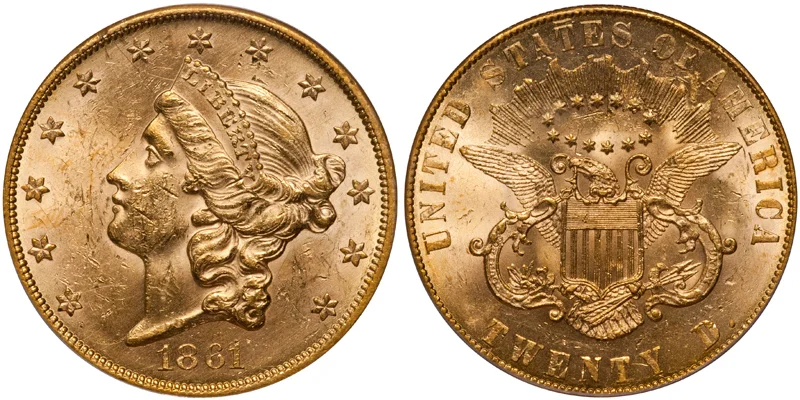The 1854-S double eagle is one of the most interesting Liberty Head double eagles. It is widely acclaimed by collectors due to its status as the first double eagle from this mint, and the rarity of the quarter eagle and half eagle from this year makes it a famous coin as well. That said, it is an issue that is not well understood and one whose rarity profile has been made confusing by inconsistencies from NGC and PCGS.
The 1854-S has a high original mintage figure of 141,468 and one would expect it to be available in higher grades. This is not necessarily the case, despite what appears to be a decent number in Uncirculated as per the grading services’ current figures.
As of August 2013, NGC had graded a total of 48 in Uncirculated, including 23 in MS63 and another 10 in MS64. PCGS had graded a total of 55 in Uncirculated, including 17 in MS63 and another three in MS64. With a total of 103 graded in Uncirculated, we can conclude that the 1854-S is only a marginally scarce coin in higher grades and it seems more available in comparably high grades (i.e., MS63 and higher) than such contemporary non-shipwreck dates from this mint as the 1855-S, 1858-S and 1859-S.
However, this is not the case.
What the NGC and PCGS populations fail to address is the fact that virtually every Uncirculated 1854-S double eagle is a shipwreck coin. And what’s worse is that these are designated on the holder as being from a shipwreck - and both services seem wildly inconsistent with how this date is graded and why some blatantly “environmental damage” coins are in “normal” holders while others are not.
Essentially every high-grade 1854-S double eagle is from the S.S. Yankee Blade shipwreck which was found in 1977. This wreck contained approximately 200-300 coins. These were Uncirculated coins which must have been spectacular before the boat carrying them sank; the survivors tend to show very few marks but they have matte-like surfaces from exposure to seawater. Some examples have less etching in the surfaces than others; some are clearly salvaged and have oxidation as well as scratches from the process of removing crud from the surfaces.
What few collectors realize is that, as with the 1854-S eagle, the survival rate of high grade 1854-S double eagles with original surfaces is exceptionally low. I have seen exactly three with original surfaces which I grade Choice AU to Mint State by today’s standards. In comparison, I have probably owned 20 examples graded MS62 to MS64 but with “unoriginal” surfaces.
The choicest 1854-S double eagles I have seen with original surfaces include a PCGS 61 from the Bass collection (ex Bass III: 781 at $10,450; I later sold this coin to a collector on the East Coast), an NGC MS61 which I bought out of a Heritage sale around ten years ago (and can’t currently remember the exact pedigree), and a PCGS AU58 which I purchased from a New York dealer around four years ago and which was very choice for the grade. I believe that a few others are known but I can stately with reasonably strong conviction that none exist in grades higher than MS61.
There are certain diagnostics seen on the Yankee Blade coin which are not seen on the coins with original surfaces. Some of these are as follows:
- The shipwreck coins always have an obverse die crack which runs up from a denticle at 6:00 on the obverse through the left side of the 5 in the date, terminating at the truncation.
- The reverse has a total of three cracks. The first runs into the field (at the viewer’s left) from the base of the N in UNITED. The second crack begins between the denticles left of the first T in TWENTY up to the left tip of the letter. The third begins at the tip of the T in TWENTY and travels left into the field ending below the N in UNITED. On the late die state, these three cracks meet below the base of the right foot of the N in UNITED.
- The shipwreck coins always show a broken crossbar in the A in STATES.
The original surface coins do not show these die cracks. They do have a similar mintmark, and all seem to have the broken crossbar. Interestingly, there are a number of small raised die dots on the obverse with two to the right of the 4 in the date, and three at the throat. There is also a small raised die dot on the neck.
I don’t believe that the original surface coins are from a different die pair than the seawater coins; just a different die state.
Breen lists four different die varieties for the 1854-S, but one of these is a Proof-only die (the unique coin in the Mint Collection) while another, described as having “extra thin numerals and letters,” is just a late state with lapped dies. He states that 8 pairs of dies were created and that the mintmark “usually…touches the tail; though on one it is free.” (He then states that on one it is “embedded.”). I have only seen one reverse and it always has a broken A in STATES and a mintmark which firmly touches the tail at its top.
There is, of course, another significant difference on the original surface coins and that is a different texture from a lack of exposure to seawater and sand.













